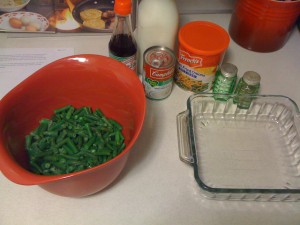Today I attended the first meeting for the BGSU Slow Foods Chapter.
 Puja Batra-Wells, Dr. Lucy Long, and several students brought a potato soup, baguette and homemade butter to share with the participants.
Puja Batra-Wells, Dr. Lucy Long, and several students brought a potato soup, baguette and homemade butter to share with the participants.
To begin, Dr. Long explained the beginnings of the Slow Food Movement, which began in Italy when several college students gathered to protest the construction of a McDonald’s. The students began rallying against the industrialization of food, in general, and Slow Food was born.
The BGSU Slow Food Chapter hopes to gain enough energy, momentum, and voices to make social change here in BG. They want to encourage dining services to use local produce when it’s available and create healthier menus for BGSU students, faculty and staff. Also, the group would like to participate in the upkeep, harvesting, and winterizing of community gardens (BG has two of them!), and they hope to create a community orchard. Additionally, the chapter hopes to come together for social events. They want to share meals at pot lucks, local restaurants, and dinner parties and create a space where folks can take time to enjoy food and talk about food. As a group, they hope to do other food-centered activities such as visit a slaughter house, learn to make cheese, share recipes, etc.
It’s no suprise that I support Slow Food and signed up to become a member!
During Puja’s dicussion of her expectations I couldn’t help but think of our GSW 1120 Honors class. We’ve discussed so many of the issues Slow Food fights for and against. I think it’s interesting that food unites us, even beyond the dinner table with our family. Today food–good food that is clean and fair–brought together 20+ students, faculty, and staff from different backgrounds and cultures. That says a lot regarding our collective desire to change the industry of today’s food.
The talk today reminded me of Dan’s presentation last week, of when he said that he has almost a spiritual experience when he eats duck that he has harvested and cleaned himself. While hunting and dressing an animal may be a bit extreme for most eaters, it’s important to realize there are plenty of options to help us develop a stronger connection to our food and foodways, and Slow Food brings together like-minded folks so we can learn from one another. I thought it would be neat to have a wild game dinner and talk about the issues surrounding hunting. Or to have a dinner at a farm where only foods harvested from that farm can be served. Event like these can foster community, inspire education, and teach us to use and enjoy foods more responsibily.
As a GSW class we’re on the brink of the Researched Essay. A lot of the issues we’ve already discussed only scatch at the surface of the thousands of food-related topics that would be perfect for our final essay. Bearing in mind, the Slow Food meeting I attended today, Dan’s presentation, and my own foodie research, I’ve started to brainstorm possible topics for a Researched Essay. For now I’m just formulating research questions: can Slow Food make an impact? What’s been the success rate of Slow Food changing local food systems? With all the use of pesticides and genetically engineered crops, is eating hunted foods, such as duck and geese, safe?
 But the question I continue going back to is one that is pretty dear to me. School lunches and dinners. Every semester I recieve countless essays about how Dining Services serves unhealthy, greasy, fried foods. Students want to see a change made to the menus Dining Services offers. My all-time favority celebrity chef, Jamie Oliver, worked tiredlessly to create healthier school lunches for kids in Britain. Can celebrity chefs change food policies, and if so what is the chance of success? I’m still figuring out an angle, but this issue is one that is important to my students, which makes it important to me.
But the question I continue going back to is one that is pretty dear to me. School lunches and dinners. Every semester I recieve countless essays about how Dining Services serves unhealthy, greasy, fried foods. Students want to see a change made to the menus Dining Services offers. My all-time favority celebrity chef, Jamie Oliver, worked tiredlessly to create healthier school lunches for kids in Britain. Can celebrity chefs change food policies, and if so what is the chance of success? I’m still figuring out an angle, but this issue is one that is important to my students, which makes it important to me.

 In honor of Lucy Long’s academic article “Green Bean Casserole and Midwestern Identity: A Regional Foodways Aesthetic and Ethos,” which was published in Midwestern Folklore’s Spring 2007 issue, I made two variations of green bean casserole:
In honor of Lucy Long’s academic article “Green Bean Casserole and Midwestern Identity: A Regional Foodways Aesthetic and Ethos,” which was published in Midwestern Folklore’s Spring 2007 issue, I made two variations of green bean casserole: